
Hospital Bed vs Regular Bed: Best for Elderly at Home with Pressure Relief
📋 KEY TAKEAWAYS
| Feature | Hospital Beds | Regular Beds |
|---|---|---|
| Pressure Relief | Superior (medical-grade mattresses) | Limited (not designed for extended use) |
| Adjustability | Full (head, foot, height) | None or very limited |
| Height | Adjustable (7"-30") | Fixed (typically 24"-26") |
| Safety Features | Side rails, locking wheels | None |
| Medicare Coverage | Yes (with prescription) | No |
| Price Range | $1,000-$5,000+ | $500-$3,000+ |
| Caregiver Support | High (ergonomic height, rails) | Poor (awkward height, no support features) |
Best Overall: Icare Adjustable Electric Home Hospital Bed IC333 – Balances medical features with home-friendly aesthetics
Budget Option: Costcare Semi-Electric Bed B120C – Essential features at $1,068
For Pressure Relief: Medacure Pro Dynamic True Low Air Loss Hospital Bed Mattress – Superior pressure management
Hospital bed vs regular bed considerations become crucial when caring for elderly loved ones at home, particularly when pressure relief is a priority.
While traditional beds serve well for typical sleep needs, they often fall short in addressing the specialized requirements of elderly individuals with limited mobility, health conditions, or those requiring extended bed rest.
After thorough analysis, the Icare Adjustable Electric Home Hospital Bed - IC333 paired with a specialized pressure relief mattress emerges as the best solution for elderly care at home. This combination provides superior pressure distribution, position adjustability, and safety features while maintaining a home-friendly appearance.
This comprehensive guide examines the critical differences between hospital beds and regular beds for elderly home care, with special attention to pressure relief capabilities, comfort, safety, and overall value. We'll also explore bariatric hospital bed options for those with higher weight requirements and discuss hospital bed mattress selections that provide optimal pressure management.
Pressure Relief Capabilities: Hospital Beds vs Regular Beds
Pressure relief is one of the most critical factors when caring for elderly individuals at home, as pressure ulcers (bedsores) can develop within hours and lead to serious complications.
| Pressure Relief Feature | Hospital Beds | Regular Beds |
|---|---|---|
| Position Adjustment | Multi-point articulation to redistribute pressure | Fixed position or limited adjustment |
| Mattress Compatibility | Works with medical-grade pressure relief surfaces | Limited to consumer mattresses |
| Weight Distribution | Engineered for prolonged weight distribution | Designed for normal sleep patterns only |
| Therapeutic Surfaces | Compatible with air, gel, and specialized foams | Limited to standard mattress materials |
| Pressure Point Management | Active management of high-risk areas | Passive, general pressure distribution |
Hospital Bed Pressure Relief Advantages
Hospital beds provide superior pressure relief through several key mechanisms:
- Articulation: Multi-point adjustability allows precise positioning to redistribute pressure away from high-risk areas like the sacrum, heels, and shoulders
- Medical-grade mattresses: Compatible with specialized hospital bed mattresses engineered specifically for pressure management
- Position changes: Electric controls facilitate frequent small position adjustments that are crucial for pressure relief
- Therapeutic systems: Can accommodate advanced systems like alternating pressure and low air loss surfaces
- Segmented design: Mattress sections move with the bed's articulation without creating shear forces
Hospital beds can be paired with specialized pressure relief mattresses like the Emerald 5-Zone Medical Foam Mattress that features targeted support zones for optimal pressure distribution.
Regular Bed Pressure Relief Limitations
Regular beds have significant limitations when it comes to pressure management:
- Fixed position: Limited or no adjustability means pressure remains concentrated on the same body areas
- Consumer mattresses: Designed for normal sleep patterns, not extended bed rest or medical conditions
- No medical integration: Cannot properly accommodate therapeutic pressure relief systems
- Improper height: Fixed height prevents optimal caregiver access for position changes
- Limited compatibility: Not designed to work with medical-grade pressure surfaces
Even high-end memory foam and air-adjustable consumer mattresses cannot match the pressure relief capabilities of medical systems like the Emerald Alternating Pressure Mattress - LAL System designed specifically for pressure ulcer prevention.
Adjustability and Positioning Benefits
The ability to adjust positions is a fundamental difference between hospital beds and regular beds, with significant implications for elderly comfort and health.
Hospital Bed Adjustment Capabilities
Hospital beds offer comprehensive position adjustments:
- Three-part articulation: Independent head, foot, and height adjustment
- Precision controls: Electric motors allow incremental position changes
- Medical positioning: Specialized positions like Trendelenburg and reverse Trendelenburg
- Height range: Typically 7"-30" from floor to mattress platform
- Position memory: Many models save preferred positions for consistent therapy
The Trendelenburg Costcare Adjustable Medical Bed B337 exemplifies these capabilities with its clinical positioning options at $1,675.
These adjustment capabilities directly benefit elderly health through:
- Improved circulation: Elevated legs reduce edema and venous issues
- Better respiration: Elevated head position eases breathing difficulties
- Reduced reflux: Head elevation helps manage GERD symptoms
- Pressure redistribution: Regular position changes prevent pressure ulcers
- Pain management: Finding optimal positions for comfort
Regular Bed Positioning Limitations
Regular beds offer minimal positioning options:
- Fixed frame: No inherent adjustability in standard beds
- Manual positioning: Requires pillows and bolsters for support
- Fixed height: Cannot be raised or lowered for transfers or care
- Limited angles: Cannot achieve therapeutic positions
- Inconsistent support: Pillow arrangements shift and compress
These limitations create several challenges:
- Pressure concentration: Weight remains on the same points
- Difficult transfers: Fixed height complicates getting in and out
- Caregiver strain: Awkward working height for providing care
- Limited therapeutic value: Cannot achieve medical positions
- Symptom management challenges: Difficult to address specific conditions
The top recommended Icare Adjustable Electric Home Hospital Bed - IC333 solves these issues with full electric adjustability while maintaining a residential appearance at $3,200.
Safety Features for Elderly Care
Safety becomes a paramount concern when caring for elderly individuals at home, particularly those with mobility challenges or cognitive impairments.
| Safety Feature | Hospital Beds | Regular Beds |
|---|---|---|
| Fall Prevention | Side rails, ultra-low height options | None (aftermarket rails only) |
| Transfer Safety | Adjustable height, stability features | Fixed height, no transfer aids |
| Mobility Support | Grab rails, assist devices | No integrated support features |
| Emergency Features | Quick position changes, stability locks | None |
| Medical Safety | FDA-regulated standards | Consumer furniture standards only |
Fall Prevention and Management
Falls represent one of the most significant risks for elderly individuals. Hospital beds provide comprehensive fall protection through:
- Integrated side rails: Prevent rolling or falling out of bed
- Ultra-low height: Beds like the Ultra Low Hospital Bed Medacure ULB3.9 can lower to just 3.9" from the floor, minimizing injury risk
- Locking mechanisms: Secure the bed in place to prevent unwanted movement
- Bed alarms: Available on some models to alert caregivers
- Controlled movement: Smooth, electric adjustments prevent jarring
Regular beds offer minimal fall protection:
- No built-in rails or barriers
- Fixed, typically high profile (24"-26" from floor)
- No locking mechanisms
- No alarm capabilities
- Unstable during transfers
Transfer Safety and Mobility Support
Safe transfers in and out of bed are critical for elderly individuals with limited mobility. Hospital beds facilitate this through:
- Optimal height adjustment: Can be precisely positioned for standing, sitting, or wheelchair transfers
- Stability features: Models like the Medacure Ultra Low Hospital Bed ULB7/30-CLS include floor lock systems
- Grab points: Side rails provide secure handholds during movement
- Edge stability: Reinforced perimeters support sitting on the edge
- Caregiver assistance: Height adjustment reduces helper strain
Regular beds create transfer challenges through:
- Fixed height rarely matching optimal transfer positions
- Unstable mattress edges that compress during transfers
- Limited secure grab points
- No locking mechanisms
- Incompatibility with transfer devices
Side Rails and Mobility Aids
Hospital beds offer integrated mobility support through properly designed side rails and accessories:
- Full-length rails: Maximum protection for high fall risk
- Half-rails: Balance between protection and independence, like the Costcare Homecare Half Rails
- Assist bars: Help with sitting up and repositioning
- Trapeze bars: Overhead assistance for self-repositioning
- Anti-entrapment design: Prevent dangerous gaps
Regular beds require aftermarket solutions that have significant limitations:
- Poor integration with the bed frame
- Potential for improper installation
- Not designed to medical safety standards
- Limited weight capacity
- May damage bed frame or void warranty
Special Considerations for Bariatric Elderly Care
Elderly individuals with higher weight requirements need specialized support that most regular beds simply cannot provide.
Bariatric Hospital Bed Advantages
Bariatric hospital beds provide essential features for higher-weight individuals:
- Enhanced weight capacity: Typically 500-1000 pounds
- Wider sleep surface: Available in 42", 48", 54" and 60" widths
- Reinforced frame: Heavy-duty construction prevents sagging and damage
- Powerful motors: Handle increased weight during adjustments
- Bariatric-specific safety features: Reinforced side rails and stronger locking mechanisms
The Costcare Bariatric Adjustable Hospital Bed B359 offers expandable width options between 54"-60" and supports up to 750 pounds at $3,457.
Regular Bed Bariatric Limitations
Regular beds present significant challenges for bariatric individuals:
- Insufficient weight rating: Most residential beds support only 300-500 pounds
- Inadequate width: Standard beds are too narrow for comfort and safety
- Structural weakness: Frames bend or break under extended heavy use
- Poor edge support: Edges collapse during transfers
- Pressure concentration: Limited distribution of higher weight loads
For bariatric needs, the Heavy Duty Hospital Bed Costcare B357 offers flexible width and length adjustments with a 600-pound capacity for $3,142.
Bariatric Pressure Management
Pressure management becomes even more critical for bariatric individuals. Hospital beds allow integration with specialized bariatric pressure management systems:
- Bariatric-specific air systems: Designed for higher weights and wider dimensions
- Reinforced pressure zones: Target areas of highest pressure
- Multi-zone support: Different pressure settings for different body areas
- Enhanced air flow: Greater cooling and moisture management
- Higher capacity pumps: More powerful systems for therapeutic benefit
The Medacure Bariatric Mattress with Low Air Loss provides specialized support for bariatric individuals with its therapeutic air system.
Cost and Insurance Considerations
The financial aspects of beds for elderly care involve more than just the initial purchase price.
| Financial Factor | Hospital Beds | Regular Beds |
|---|---|---|
| Initial Cost | $1,000-$5,000+ | $500-$3,000+ |
| Medicare Coverage | Yes - 80% when prescribed | No |
| Out-of-Pocket Cost | Often lower after insurance | Full retail price |
| Long-Term Value | Higher (durability, features) | Lower (replacement needs) |
| Healthcare Costs | Reduced (prevents complications) | Potentially higher (more issues) |
Insurance Coverage and Medicare
A significant financial advantage for hospital beds is potential insurance coverage:
- Medicare Part B: Covers approximately 80% of the approved amount when prescribed by a physician
- Medicare Advantage: Similar coverage but with network restrictions
- Medicaid: May cover 100% for qualifying individuals
- Private insurance: Variable coverage depending on policy and medical necessity
- Documentation requirements: Physician prescription and medical necessity verification
The Costcare Semi-Electric Bed B120C at $1,068 is an excellent budget-friendly option that typically qualifies for coverage.
Regular beds are generally not covered by insurance because:
- They are not classified as durable medical equipment (DME)
- They lack necessary medical features
- They are considered standard household furniture
- They don't meet coding requirements for reimbursement
Total Cost of Ownership
When evaluating total cost of ownership, several factors beyond initial price should be considered:
- Durability: Hospital beds typically last 10-15 years vs. 5-7 for regular beds
- Adaptability: Hospital beds adjust to changing needs without replacement
- Complication prevention: Specialized features prevent costly medical issues
- Caregiver health: Proper equipment reduces caregiver injuries and associated costs
- Resale value: Medical equipment maintains better value than residential furniture
Home Modification Considerations
Both bed types may require home modifications, but with different considerations:
Hospital beds typically require:
- Adequate doorway clearance (36" minimum)
- Reinforced electrical outlets
- Space around all sides for caregiver access
- Room for accessory equipment
The Emerald Hospital Adjustable Bed Oasis 52200 offers a space-efficient design that minimizes home modification needs at $1,940.
Regular beds may require extensive modifications to serve elderly needs:
- Aftermarket rails and supports
- Transfer equipment installation
- Lifting systems for caregivers
- Extensive pillow arrangements
- Possible room reconfigurations as needs increase
Practical Home Integration and Aesthetics
The visual integration of medical equipment into home environments impacts psychological wellbeing.
Modern Hospital Bed Designs
Modern hospital beds increasingly offer residential aesthetics:
- Decorative headboards: Wood finishes that match home decor
- Concealed medical components: Motors and mechanisms discreetly hidden
- Color options: Beyond traditional white
- Bed skirt compatibility: Allows for decorative elements
- Designer models: Some brands focus specifically on home-friendly designs
The top-recommended Icare Adjustable Electric Home Hospital Bed - IC333 exemplifies home-friendly hospital bed design at $3,200.
Space and Room Layout Requirements
Both bed types have different space requirements:
Hospital beds typically require:
- Standard dimensions: Usually 36"-42" wide by 80" long
- Clearance: 3-4 feet on all sides for caregiver access
- Electrical access: Proximity to outlets
- Doorway clearance: 36" minimum for delivery
Models like the TransferMaster Full Electric Hi-Lo Hospital Bed Supernal 3 offer exceptional functionality while respecting space constraints.
Regular beds have different spatial considerations:
- Standard residential dimensions (Twin to King)
- Less clearance needed for basic use
- Greater variety of design options
- May not accommodate medical equipment
Our Top Recommendations for Elderly Home Care
After comprehensive analysis of both hospital beds and regular beds for elderly care, these options emerge as our top recommendations.
Best Overall: Icare Adjustable Electric Home Hospital Bed - IC333
The Icare Adjustable Electric Home Hospital Bed - IC333 represents the ideal balance of medical functionality and home aesthetics at $3,200.
Key features include:
- Full electric control of all positions
- Home-friendly design that blends with residential decor
- Medical-grade construction for safety and durability
- Compatible with pressure relief mattresses
- Height range suitable for both transfers and caregiver access
Best Budget Option: Costcare Semi-Electric Bed B120C
For cost-conscious situations, the Costcare Semi-Electric Bed B120C delivers essential features at $1,068.
Key benefits include:
- Electric head and foot adjustment with manual height
- Medicare eligibility for potential coverage
- Compatible with standard safety rails
- Durable medical-grade construction
- Good value-to-feature ratio
Best for Pressure Relief: Medacure Pro Dynamic True Low Air Loss System
For maximum pressure relief, we recommend pairing any hospital bed with the Medacure Pro Dynamic True Low Air Loss Hospital Bed Mattress.
Superior pressure features include:
- Active air circulation to manage moisture and heat
- Zoned air cells for targeted pressure management
- Digital control system for precise therapy settings
- Medical-grade materials for infection control
- Compatible with most hospital bed frames
Frequently Asked Questions
Will Medicare cover a hospital bed for elderly home care?
Yes, Medicare Part B covers 80% of the approved amount when prescribed by a doctor as medically necessary.
Can a regular bed be modified for elderly care needs?
Limited modifications are possible, but they're rarely as effective as a proper hospital bed for long-term care.
What's the most important feature for pressure relief in elderly care?
Position adjustability combined with a specialized pressure-relief mattress provides the best prevention of pressure ulcers.
Are hospital beds worth the extra cost for elderly home care?
Yes, especially when considering potential insurance coverage, complication prevention, and caregiver support benefits.
Can hospital beds look like normal furniture?
Modern hospital beds have significantly improved in appearance, with many featuring residential-style designs.
What mattress is best for pressure relief on a hospital bed?
Alternating pressure air mattresses with low air loss features provide the most effective pressure management.
How low should a hospital bed go to prevent fall injuries?
Ultra-low beds that descend to 7" or lower provide the best fall injury prevention for high-risk elderly individuals.
















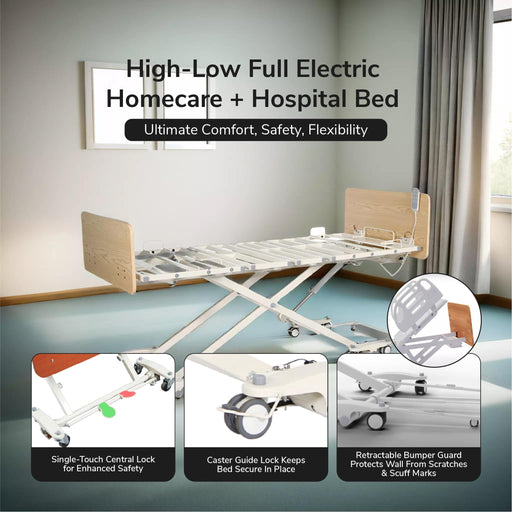
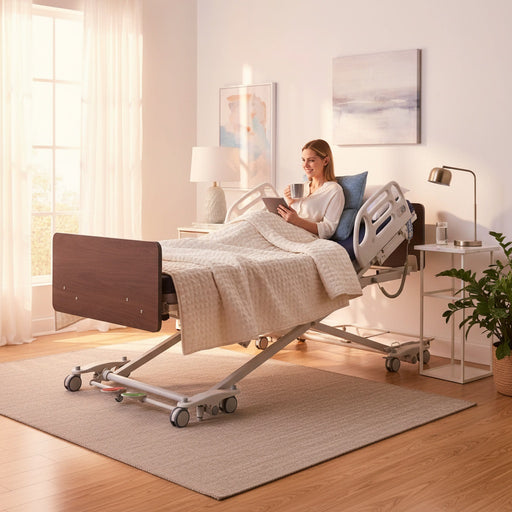
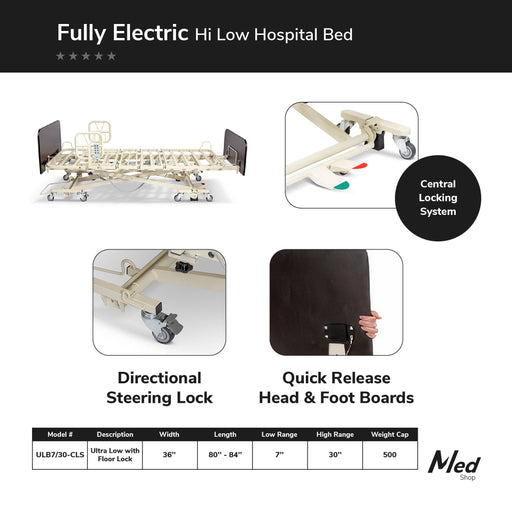
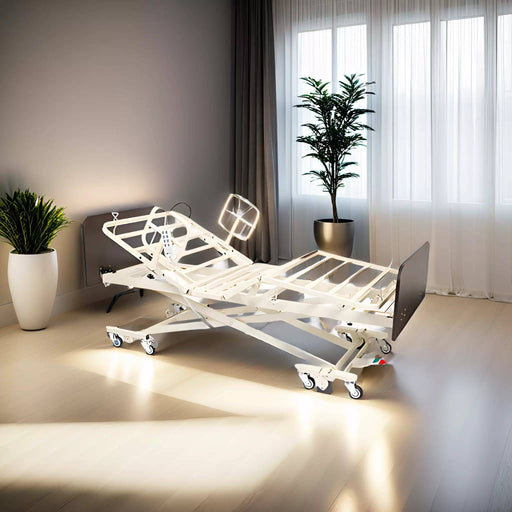


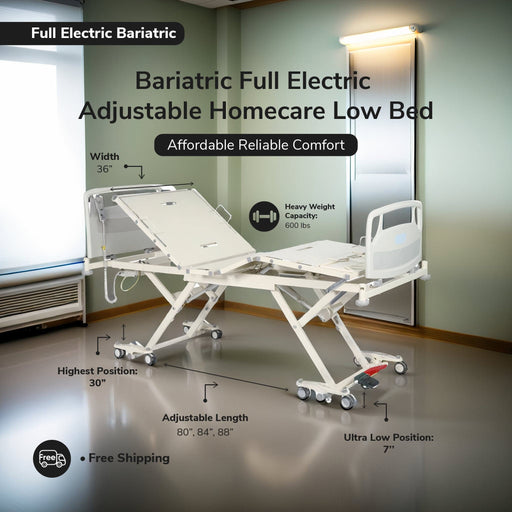
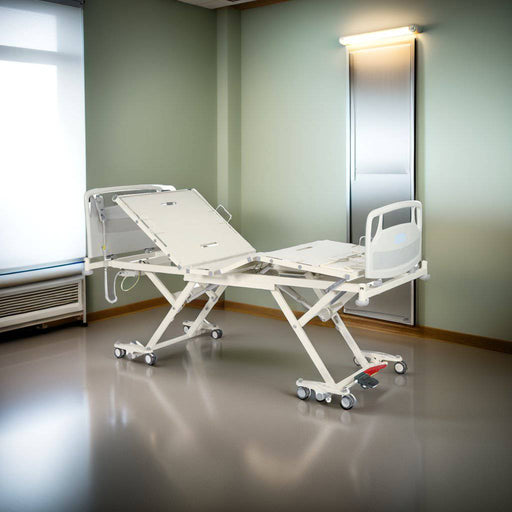
Leave a comment